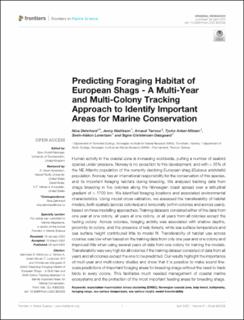Predicting Foraging Habitat of European Shags - A Multi-Year and Multi-Colony Tracking Approach to Identify Important Areas for Marine Conservation
Dehnhard, Nina; Mattisson, Jenny; Tarroux, Arnaud; Anker-Nilssen, Tycho; Lorentsen, Svein-Håkon; Christensen-Dalsgaard, Signe
Peer reviewed, Journal article
Published version

Åpne
Permanent lenke
https://hdl.handle.net/11250/2995012Utgivelsesdato
2022Metadata
Vis full innførselSamlinger
- Publikasjoner fra CRIStin - NINA [2364]
- Scientific publications [1392]
Originalversjon
10.3389/fmars.2022.852033Sammendrag
Human activity in the coastal zone is increasing worldwide, putting a number of seabird species under pressure. Norway is no exception to this development, and with > 35% of the NE Atlantic population of the currently declining European shag (Gulosus aristotelis) population, Norway has an international responsibility for the conservation of this species, and its important foraging habitats during breeding. We analysed tracking data from shags breeding in five colonies along the Norwegian coast spread over a latitudinal gradient of > 1700 km. We identified foraging locations and associated environmental characteristics. Using model cross-validation, we assessed the transferability of habitat models, both spatially (across colonies) and temporally (within colonies and across years), based on three modelling approaches: Training datasets consisted either of the data from one year at one colony, all years at one colony, or all years from all colonies except the testing colony. Across colonies, foraging activity was associated with shallow depths, proximity to colony, and the presence of kelp forests, while sea surface temperature and sea surface height contributed little to model fit. Transferability of habitat use across colonies was low when based on the training data from only one year and one colony and improved little when using several years of data from one colony for training the models. Transferability was very high for all colonies if the training dataset consisted of data from all years and all colonies except the one to be predicted. Our results highlight the importance of multi-year and multi-colony studies and show that it is possible to make sound finescale predictions of important foraging areas for breeding shags without the need to track birds in every colony. This facilitates much needed management of coastal marine ecosystems and the protection of the most important feeding areas for breeding shags. expectation-maximization binary clustering (EMBC), Norwegian coastal zone, kelp forest, bathymetry, foraging range, sea surface temperature, sea surface height, model transferability
